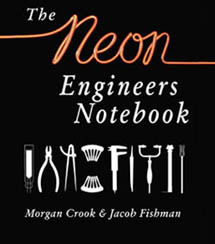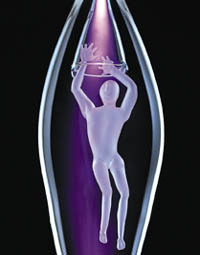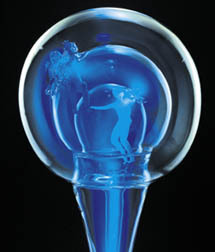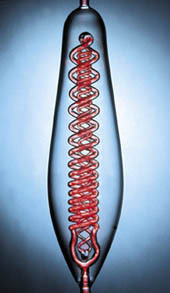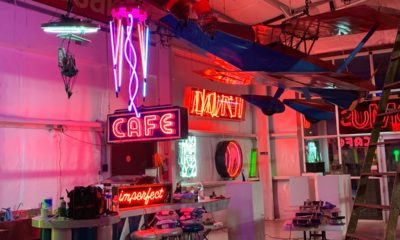BEING AN INDEPENDENT neon consultant, I consequently avoid evaluating products or brands, but I welcomed reviewing neon literature’s new kid on the block, The Neon Engineers Notebook, by Morgan Crook and Jacob Fishman (Lightwriters Neon Inc., Northbrook, IL, and also available from ST Books, Cincinnati, (800) 925-1110).
The content of The Neon Engineers Notebook answered many practical questions not addressed in Miller’s book. However, note that this new release isn’t intended for novice neon signmakers. As a reference book for troubleshooting problems, The Neon Engineers Notebook also offers tips for improving neon skills.
To me, every technical book, especially a reference handbook, must feature a detailed index. Thus, I typically examine a book’s index first. In this case, I tried to find something about "snaking" tubes and was unsuccessful — the index led me to three pages that mentioned the word, but I couldn’t find any explanation.
Next, my search for "mercury dispensing" led me directly to a spread, which depicted some information. However, surprisingly, none of the recent, mercury-dispensing methods, using mercury-containing electrodes offered by several manufacturers, was mentioned.
A look inside
In the book’s introduction, Fishman states that his main intention isn’t to teach readers how to make neon, but, rather, guide readers to determine which techniques and parameters they deem essential for setting their personal standard of quality (Fig. 1) to succeed in the long run.
The book’s first five (or if taken strictly, 11) chapters deal with tube processing. First, Crook and Fishman stress the importance of a vacuum system properly equipped with meters and gauges to monitor critical bombarding parameters. Then (not from afar, as Crook has co-produced the ISA pumping-instruction video), this book, for the first time, tries to explain how a proper neon-tube process is undertaken and which parameters must be within certain ranges.
The first statement in the book’s paragraph about pumping methods rings true: "For most of the 20th Century, pumping neon tubes was shrouded in a mystery."
According to Fishman, you can’t learn bombarding simply by reading a book. Rather, it’s a task that’s best learned under the guidance of an experienced individual.
Further, an entire chapter, dedicated to possible solutions for the dimming-red problem (see ST, March 2000, page 72), suggests helium bombardment to heat the tubes to a proper temperature. From my experience, Fishman’s suggested helium pressure of 4mbar isn’t sufficient. I suggest a pressure of approximately 15mbar to achieve enough heat in the glass.
Another chapter discusses tube aging — Crook conducted numerous experiments to determine whether there might be a certain "de-aging" process, or, what might be a sufficient aging time. According to his findings, 10 minutes on the aging table should be sufficient for red-neon tubes.
Although I appreciate the amount of work both authors have invested, I don’t agree this short aging time will achieve stable and proper operating values. The book fails to mention a tube’s electrical-operating characteristics, which only stabilize after several hours of aging (see ST, February 1999, page 52).
More good stuff
Neon glasswork creates the shape and beauty of a neon sign and, therefore, is the main task (in addition to tube processing) of neon signmakers. Handcrafting neon glass (tubebending) is just briefly mentioned in Miller’s book.
Here, Fishman and Crook provide several tips and answers to frequently asked questions, such as the correct burner type ("A" or "N") to use for a specific gas. The authors also cover all basic operations of manipulating liquid-glass tubing, providing numerous recipe-like descriptions.
However, because The Neon Engineers Notebook isn’t intended for beginners, it doesn’t appear to be as detailed about glasswork as Randy Caba’s book, The Neon Superguide.
In addition, the book features several chapters on non-standard-sign neon glasswork . Glass properties, tools, fires and required techniques are among the topics covered.
Also in these chapters, the authors encourage readers to look beyond standard neon-signmaking practices and explore new territories. In addition to providing recipe-like details, the writers mention other helpful books, videos and material sources. However, keep in mind that many of the Website addresses the authors provide can quickly become outdated.
Finally, the last chapter contains helpful information about the business aspect of operating a neon shop.
Overall, The Neon Engineers Notebook is a treasure for anyone interested in learning more about neon-signmaking techniques. Although it isn’t intended for beginners, this book is a must-have for experienced craftspeople. It makes you hungry for more neon and art varieties. Thus, you better check it out before it’s sold out.
Sally Prasch’s Lampworked Neon Art
Featured in The Neon Engineers Notebook, but worthy of more than a brief mention, is the sculptural neon artwork of Sally Prasch, one of the most famous lampworking glassblowers of our time.
Commencing her glassblowing career in 1970, Sally has worked in reputable university glass studios and received numerous awards (many of them from Corning Glass).
According to Sally, "Glass is a limitless media for expression, showing flexibility, sound, sharpness, size and movement."
Currently, she teaches classes at Penland’s School of Crafts and other specialty schools. For further information about Sally’s handcrafted design masterpieces, visit www.praschglass.com.
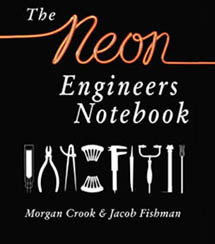


 Tip Sheet3 days ago
Tip Sheet3 days ago
 Business Management1 week ago
Business Management1 week ago
 Women in Signs2 weeks ago
Women in Signs2 weeks ago
 Real Deal4 days ago
Real Deal4 days ago
 Editor's Note1 week ago
Editor's Note1 week ago
 Line Time2 weeks ago
Line Time2 weeks ago
 Product Buying + Technology1 week ago
Product Buying + Technology1 week ago
 Women in Signs4 days ago
Women in Signs4 days ago